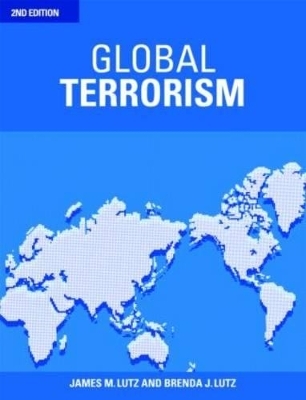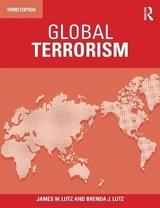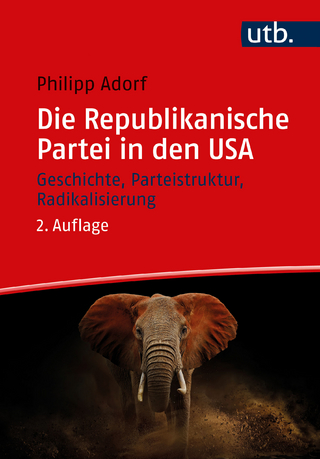
Global Terrorism
Routledge (Verlag)
978-0-415-77247-1 (ISBN)
- Titel erscheint in neuer Auflage
- Artikel merken
Global Terrorism 2nd edition continues to provide students with the most comprehensive introduction to terrorism as a global phenomenon. It introduces students to history, politics, ideologies and strategies of both contemporary and older terrorist groups.
Written in a clear and accessible style, each chapter explains a different aspect of terrorism and illustrates this with a wide variety of detailed case studies from across the world. Although the focus is on the contemporary, the book also includes discussion of older terrorist groups.
Building on the strengths of the first edition, this edition includes new material on:
July 7 attacks in London
Bali bombings
domestic terrorism in Columbia
attacks in Iraq
Al Qaeda, the Tamil Tigers, the IRA
animal rights extremism
The unique combination of a genuinely historical focus and truly global coverage makes this an ideal introductory textbook for anyone studying terrorism.
James M. Lutz is Professor of Political Science at Indiana University-Purdue University at Fort Wayne. He has long been interested in various types of political violence. Brenda J. Lutz is a PhD candidate at the Department of Politics, University of Dundee, Scotland, focusing on violence in the animal rights movement and factory farming.
1. Terrorism in the World, Today and Yesterday 1.1 Terms 1.2 Further reading 2. What is Terrorism? Definition and Classification 2.1 Defining Terrorism 2.2 Classification and Categories 2.3 Causes of Terrorism 2.4 Prevalence of Terrorism 2.5 Summary 2.6 Terms 2.7 Further reading 3. Tactics, Weapons, and Targets 3.1 Techniques 3.2 Weapons 3.3 Targets 3.4 Summary 3.5 Terms 3.6 Further reading 4. State Sponsors and Supporters of Terrorism 4.1 True State Control 4.2 State Support of Foreign Terrorists 4.3 Case Studies 4.3.1 Italy and Hungary—Fishing in Troubled Waters 4.3.2 Iran 4.3.3 The United States and the Contras in Nicaragua 4.3.4 The Cold War between India and Pakistan 4.4 Summary 4.5 Terms 4.6 Further reading 5. Religious Justification for Terrorism 5.1 Terrorism and the World’s Religions 5.2 Case Studies 5.2.1 The Zealots in Judea 5.2.2 The Sikhs and Khalistan 5.2.3 Algeria in the 1990s 5.2.4 Aum Shinrikyo (Supreme Truth) 5.2.5 Anti-Abortion Activities in the United States 5.2.6 Osama bin Laden and the Al Qaeda Network 5.3 Summary 5.4 Terms 5.5 Further reading 6. Ethnic and National Bases of Terrorism 6.1 Modernity and Ethnic Conflict 6.2 Case Studies 6.2.1 The Boston Tea Party 6.2.2 Basque Nationalists in Spain 6.2.3 Dayaks and Migrants in Borneo 6.2.4 Albanians in Kosovo and Macedonia 6.2.5 The Palestinian Liberation Organization and the Struggle with Israel 6.3 Summary 6.4 Terms 6.5 Further reading 7. Terrorism and Ideologies of the Left 7.1 Ideology and Beliefs 7.2 Dissatisfaction from the Left 7.3 Case Studies 7.3.1 The Baader-Meinhof Gang in West Germany 7.3.2 The Italian Red Brigades 7.3.3 The Montoneros in Argentina 7.3.4 Naxalites in India 7.3.5 The Animal Liberation Front and the Animal Rights Militia 7.4 Summary 7.5 Terms 7.6 Further reading 8. Terrorism and Ideologies of the Right 8.1 Right Wing Dissatisfaction: Marxism and Minorities 8.2 Case Studies 8.2.1 Stormtroopers in Weimar Germany 8.2.2 The Ku Klux Klan (1920s and 1930s) 8.2.3 Neo-Fascism in Postwar Italy 8.2.4 The American Militia/Patriot Movement 8.2.5 Neo-Nazis and Skinheads in Europe 8.3 Summary 8.4 Terms 8.5 Further reading 9. Terrorism and Multiple Motivations 9.1 Terrorist Campaigns with Complex Causes 9.2 Case Studies 9.2.1 Leftists and Indigenous Populations in Peru 9.2.2 Irish Republicanism 9.2.3 Colombia—Regionalism, Ideology, and Narcotics 9.2.4 Nigeria—Religion and Region, Ethnicity and Environmentalism 9.3 Summary 9.4 Terms 9.5 Further reading 10. State Use of Domestic Terrorism and Repression 10.1 Government Induced Fear and Compliance 10.2 Government Complicity in Terrorism by Non-State Groups 10.3 Genocide and Ethnic Cleansing 10.4 Case Studies 10.4.1 Terror in the First Years of the French Revolution 10.4.2 Paramilitary Militias in East Timor 10.4.3 Farm Invasions in Zimbabwe 10.4.4 Ethnic Cleansing in Bosnia and Herzegovina 10.4.5 Ethnic Cleansing in the Sudan 10.4.6 Genocide in Rwanda 10.5 Summary 10.6 Terms 10.7 Further reading 11. Countries with Multiple Crises of Terrorism 11.1 The Prevalence of Multiple Crises 11.2 Waves of Violence and Terrorism in Sri Lanka 11.3 Terrorism and Insurgency in Iraq 11.4 Summary 11.5 Terms 11.6 Further reading 12. Counterterrorism 12.1 Techniques of Counterterrorism 12.2 Weapons of Mass Destruction and Mass Casualties 12.3 Summary 12.4 Terms 12.5 Further reading 13. Terrorism: A Continuing Phenomenon 13.1 Why Terrorism Continues 13.2 What We Know from the Historical Experience Glossary Bibliography
| Erscheint lt. Verlag | 8.7.2008 |
|---|---|
| Zusatzinfo | 6 Line drawings, black and white; 6 Tables, black and white; 6 Illustrations, black and white |
| Verlagsort | London |
| Sprache | englisch |
| Maße | 189 x 246 mm |
| Gewicht | 680 g |
| Themenwelt | Sozialwissenschaften ► Politik / Verwaltung ► Vergleichende Politikwissenschaften |
| ISBN-10 | 0-415-77247-8 / 0415772478 |
| ISBN-13 | 978-0-415-77247-1 / 9780415772471 |
| Zustand | Neuware |
| Haben Sie eine Frage zum Produkt? |
aus dem Bereich



